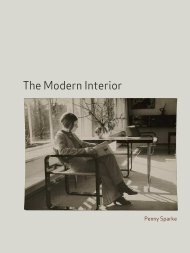Landscape Architecture: Landscape Architecture: - School of ...
Landscape Architecture: Landscape Architecture: - School of ...
Landscape Architecture: Landscape Architecture: - School of ...
- No tags were found...
Create successful ePaper yourself
Turn your PDF publications into a flip-book with our unique Google optimized e-Paper software.
The mining landscape at Cospuden, transformed into a mining memory landscape as a framework for development.<br />
were shortly invited to visit Seoul, close to which a<br />
remarkable concept had been envisioned – ‘Paju Book City’.<br />
Along the edge <strong>of</strong> the Han River northwest <strong>of</strong> the South<br />
Korean capital, Seoul, before a distant prospect <strong>of</strong> mountains<br />
and close to the sea, the architects realised that here was a<br />
client that possessed a clear, if not fully defined vision <strong>of</strong> what<br />
a 21st-century technologically based city might comprise.<br />
When a man rides for a long time through wild regions he feels the<br />
desire for a city.<br />
… Isidora is the city <strong>of</strong> his dreams: with one difference. The<br />
dreamed <strong>of</strong> city contained him as a young man; he arrives at Isidora<br />
in his old age … Desires are already memories.<br />
Italo Calvino 3<br />
In the spring <strong>of</strong> 1999, Florian Beigel and ARU were<br />
commissioned to design the urban landscape plan <strong>of</strong> Paju<br />
Book City. The ARU plan was used as the basis <strong>of</strong> the Paju<br />
Design Guide, produced in August 1999 by a team comprising<br />
the architects Seung H-Sang (co-ordinator), Florian Beigel, Min<br />
Hyun-sik, Kim Jong Kyu and Kim Young-joon. A range <strong>of</strong><br />
architectural typologies emerged. One extended below the<br />
defining Freedom Expressway (formerly the Ja Yoo motorway<br />
and today also a major 10-metre/32-foot high flood barrier<br />
along the east bank <strong>of</strong> the river). Called Highway Shadow, this<br />
was to contain mostly mass-production facilities such as print<br />
shops, publishing houses and factories, buildings, restricted to<br />
two storeys, that would have green ro<strong>of</strong>s and would not<br />
exceed the height <strong>of</strong> the highway. Another architectural type<br />
was dubbed Bookshelf units – a series <strong>of</strong> ‘chopped volumes’,<br />
yet giving the working inhabitants unrestricted views <strong>of</strong> the<br />
Han River and the Simhak Mountain. Other poetic concepts<br />
included Stone units, with massive forms akin to geological<br />
rock, and a ‘Canal L<strong>of</strong>t’ running out rhythmic lines along the<br />
length <strong>of</strong> the waterway. An Urban Island would be recognised<br />
from the roads surrounding all four sides <strong>of</strong> the site. This<br />
91



